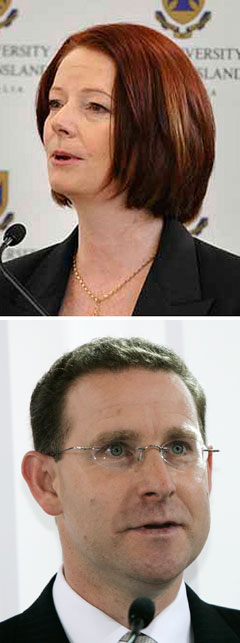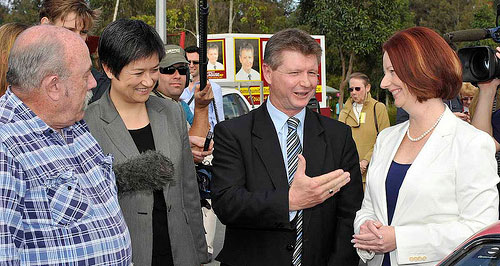Make / Model Search
News - General NewsGillard promises cash for clunkersOut with the old: Sales of small imported cars are likely to spike under Labor's proposed scrappage scheme. $394 million pledged to rid Aussie roads of inefficient pre-1995 cars27 Jul 2010 THE Gillard government’s proposed $394 million cash-for-clunkers scheme would only benefit importers of low-end vehicles to the detriment of the local industry, according to the opposition and key industry sources. While local manufacturers declined to comment on the policy during the election campaign, GoAuto sources confirmed the scheme was expected to result in few sales of locally produced cars. Under the proposal, which was announced last weekend by prime minister Julia Gillard, Australian motorists would qualify for an incentive of $2000 to buy a new, fuel efficient car from January 1, 2011. They would be required to trade in a pre-1995 vehicle on a new vehicle with an average CO2 emission rating of 220g/km or less. The old cars would be scrapped. A GoAuto source said the scheme would likely benefit brands with the cheapest new cars on the market, which are all imported, as these vehicles were generally popular with motorists graduating from a used model. “The kind of people driving cars that are worth less than $2000 as a trade-in are unlikely to buy anything but the cheapest new cars,” said the source. The type of vehicles eligible under the program has also attracted criticism, with the opposition leading the attack.  Left: Prime minister Julia Gillard. Below: FCAI chief executive Andrew McKellar. Left: Prime minister Julia Gillard. Below: FCAI chief executive Andrew McKellar.Liberal industry spokesperson Sophie Mirabella said: “This is a deeply flawed program with the (regular) Toyota Camry and hybrid Camry the only eligible Australian-made vehicles. It will inevitably undermine local jobs.” According to the government’s Green Vehicle Guide, the 3.0-litre V6-powered Holden Commodore misses out on qualifying for the scheme by 1g/km of emissions. Ms Gillard mentioned the Australian-made four-cylinder Ford Falcon EcoBoost would qualify, but it is not due for release until the first quarter of 2011 and its emissions ratings have not been finalised. The Holden Cruze small car, which is due to begin production in South Australia early next year, should be eligible under the scheme. A long list of imported vehicles qualify under the scheme include the big-selling Toyota Corolla, Mazda3, Mitsubishi Lancer, Hyundai Getz and Holden Barina. However, concerns have been raised that the scheme could be open to rorting. The South Australian state executive director of the Motor Trade Association, John Chapman, said the program could “distort the market if people can go out and pick up an old bomb for a few hundred dollars and then trade it in for the $2000 rebate”. A Labor statement appeared to combat this concern by stating the vehicles to be turned in must also have been registered and insured by the person claiming the rebate for 24 months prior. It must be a passenger vehicle and be petrol- or diesel-fuelled. Labor said that the new vehicle to be bought by an individual and not a business and not incur the luxury car tax. Federal Chamber of Automotive Industries (FCAI) chief executive Andrew McKellar supports the plan but would want further clarification should Labor be returned to government. “There are a lot of things that still need to be detailed,” he told GoAuto this week. He said the FCAI was concerned that the program could have a disruptive effect on the industry prior to its introduction. “We need to ensure the competitive impact or distortion it might have on the market is assessed,” he said. “We would be concerned that any pulling back (of sales) would be considered.” Mr McKellar said the scrappage scheme was quite targeted and “wasn’t going to help everybody”, but he still supported it. “We welcome any move to help motorists move away from older vehicles and into more efficient and far safer vehicles. Getting 200,000 of these old, inefficient vehicles off the road is a useful contribution if it can be achieved,” he said. Mr McKellar said state governments could do more to move motorists out of older vehicles by tightening up vehicle checks which the FCAI says allows many unroadworthy vehicles to remain in the vehicle fleet. The cash-for-clunkers program announcement represents a dramatic policy change after the Rudd government dismissed such schemes that were introduced overseas in 2009 in response to the global financial crisis. Federal industry minister Kim Carr told GoAuto in March 2009 that a car scrappage scheme was not on the cards because “it’s extremely expensive and there are finite resources for the government”. Instead, the government used a 30 per cent and then 50 per cent Capital Investment Allowance for businesses to stimulate the new-car market to the end of 2009. Last year, Senator Carr estimated a scrappage scheme would cost $1 billion, but the new scheme will be capped at $394 million, covering 200,000 motorists and running for no more than four years. The $2000 incentive is modest compared to the $5000 stumped up under the German government’s scrappage scheme. The British system offered motorists $3500 and the US program offered $5000. Initially, the US government pledged $US1 billion for its cash for clunkers scheme, but that money lasted just one week. It ended up investing another $US2 billion by the time the scheme wound up in August 2009. It is not clear exactly what kind of response the Gillard government cash-for-clunker proposal would generate, but it would offer significantly less money than the US program. The Labor scrappage scheme would be financed using funds that had been previously allocated to environmental initiatives including solar energy generation development, carbon capture research and rebates for the Renewable Energy Bonus Scheme, which helps householders reduce emissions. Prime minister Gillard said it was important to reduce the average age of cars on Australian roads, which is sitting at 9.7 years, behind the European Union at eight years and Japan at 6.2 years. “Australians own a lot of old motor cars and those old cars guzzle a lot of petrol and they spew out a lot of pollution,” she said. “When we look at climate change and our nation’s carbon footprint, light vehicles contribute about 10 per cent of that carbon footprint. So the practical measures we can take to make a difference to the kind of vehicles that people drive,” she said. Labor says the plan will save motorists $344 million in fuel costs and cut one million tonnes of CO2 emissions. Ms Mirabella suggested the cost of the program dramatically outweighed the environmental benefits. “Under this program, Labor will be paying a staggering $394 per tonne of CO2 abatement, when the government’s own discredited ETS priced carbon at less than $30 per tonne,” she said. “This is the most ill-thought-out program imaginable and will inevitably result in the Gillard government wasting tens-of-millions of taxpayer dollars.”  Read more7th of July 2009  British scrappage scheme boosts salesUK ‘cash for clunkers’ scheme accounts for almost 10 per cent of June new-car sales15th of May 2009  Audi Oz supports scrappage callAudi boss declares a Euro-style scrap incentive ‘a very good idea’ |
Click to shareGeneral News articlesResearch General News Motor industry news |











Facebook Twitter Instagram